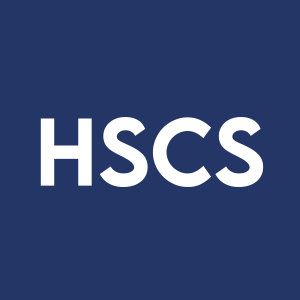HeartSciences Receives FDA Breakthrough Device Designation for MyoVista Insights AI-ECG Algorithm for Detecting Aortic Stenosis
Rhea-AI Summary
Positive
- FDA Breakthrough Device designation received for the aortic stenosis ECG algorithm
- Algorithm can detect aortic stenosis up to 24 months before confirmatory echocardiography
- Technology integrates directly with hospital EHR systems requiring no additional hardware
- Large training dataset of over 120,000 ECG records enhances algorithm reliability
- Expands access to early diagnosis, especially in underserved areas
Negative
- Product still requires FDA clearance before commercialization
- Technology limited to detecting moderate-to-severe cases of aortic stenosis
News Market Reaction 1 Alert
On the day this news was published, HSCS declined 4.06%, reflecting a moderate negative market reaction.
Data tracked by StockTitan Argus on the day of publication.
Aortic Stenosis is a Serious and Widespread Condition; The AI-ECG Algorithm Offers a Powerful Diagnostic Solution Designed for Seamless Integration with Hospital EHR Systems
Southlake, TX, June 04, 2025 (GLOBE NEWSWIRE) -- HeartSciences Inc. (Nasdaq: HSCS; HSCSW) (“HeartSciences” or the “Company”), an artificial intelligence (“AI”) powered medical technology company focused on advancing the capabilities of ECGs/EKGs for the earlier detection of heart disease, today announced that the U.S. Food and Drug Administration (“FDA”) has granted Breakthrough Device designation for its Aortic Stenosis (“AS”) ECG algorithm.
Aortic Stenosis is one of the most serious and common heart valve diseases, often progressing silently and leading to severe, life-threatening outcomes if left undetected. Early symptoms are frequently vague or absent, resulting in delayed diagnosis and treatment. If unrecognized, AS can cause irreversible myocardial damage and significant deterioration in cardiac function.
The algorithm would offer a novel, AI-driven ECG solution capable of detecting moderate-to-severe aortic stenosis. Once cleared by the FDA, the algorithm will be accessible through HeartSciences' MyoVista Insights™ cloud-based platform which would directly integrate with hospital electronic health record (“EHR") systems, requiring no additional hardware or testing. This technology provides several key clinical advantages:
- Detection in asymptomatic or under-evaluated patients who may not yet show signs of AS.
- Real-time or retrospective analysis using existing ECG data already captured during routine care.
- Expanded access to early diagnosis, especially in underserved areas lacking specialized cardiac imaging or providers.
The algorithm was developed using advanced convolutional neural network (CNN) deep learning techniques and trained on more than 120,000 ECG records. In performance evaluations, it demonstrated the ability to detect aortic stenosis up to 24 months prior to confirmatory echocardiography, with diagnostic accuracy (AUROC) increasing as the disease progressed.
This breakthrough gives clinicians the ability to identify aortic valve disease earlier in its course, allowing for timely interventions and improved patient outcomes. The AI-ECG algorithm was developed at the Icahn School of Medicine at Mount Sinai by Dr. Akhil Valid.
"Receiving FDA Breakthrough Device Designation marks another significant milestone for HeartSciences," said Andrew Simpson, CEO of HeartSciences. "By combining the widespread accessibility of ECGs with the power of deep learning, our aortic stenosis algorithm has the potential to transform how this serious and often silent disease is detected—leading to earlier referrals, better treatment pathways, and ultimately, improved lives."
About HeartSciences
HeartSciences is a medical technology company focused on applying innovative AI-based technology to an ECG (also known as an EKG) to expand and improve ECG’s clinical utility. Millions of ECGs are performed every week and the Company's objective is to improve healthcare by making it a far more valuable cardiac screening tool, particularly in frontline or point-of-care clinical settings. HeartSciences has one of the largest libraries of AI-ECG algorithms and intends to provide these AI-ECG algorithms on a device agnostic cloud-based solution as well as a low-cost ECG hardware platform. Working with clinical experts, HeartSciences ensures that all solutions are designed to work within existing clinical care pathways, making it easier for clinicians to use AI-ECG technology to improve their patient's care and lead to better outcomes. HeartSciences' first product candidate for FDA clearance, the MyoVista® wavECG™, or the MyoVista®, is a resting 12-lead ECG that is also designed to provide diagnostic information related to cardiac dysfunction which has traditionally only been available through the use of cardiac imaging. The MyoVista® also provides conventional ECG information in the same test.
For more information, please visit: https://www.heartsciences.com. X: @HeartSciences
Safe Harbor Statement
This announcement contains forward-looking statements within the meaning of Section 27A of the Securities Act of 1933, as amended, and Section 21E of the Securities Exchange Act of 1934, as amended. These forward-looking statements are made under the "safe harbor" provisions of the Private Securities Litigation Reform Act of 1995 and are relating to the Company's future financial and operating performance. All statements, other than statements of historical facts, included herein are "forward-looking statements" including, among other things, statements about HeartSciences' beliefs and expectations. These statements are based on current expectations, assumptions and uncertainties involving judgments about, among other things, future economic, competitive and market conditions and future business decisions, all of which are difficult or impossible to predict accurately and many of which are beyond the Company's control. The expectations reflected in these forward-looking statements involve significant assumptions, risks and uncertainties, and these expectations may prove to be incorrect. Investors should not place undue reliance on these forward-looking statements, which speak only as of the date of this press release. Potential risks and uncertainties include, but are not limited to, risks discussed in HeartSciences' Annual Report on Form 10-K for the fiscal year ended April 30, 2024, filed with the U.S. Securities and Exchange Commission (the "SEC") on July 29, 2024, HeartSciences’ Quarterly Report on Form 10-Q for the fiscal quarter ended July 31, 2024, filed with the SEC on September 12, 2024, HeartSciences’ Quarterly Report on Form 10-Q for the fiscal quarter ended October 31, 2024, filed with the SEC on December 16, 2024, HeartSciences’ Quarterly Report on Form 10-Q for the fiscal quarter ended January 31, 2025, filed with the SEC on March 13, 2024 and in HeartSciences' other filings with the SEC at www.sec.gov. Other than as required under the securities laws, the Company does not assume a duty to update these forward-looking statements.
Investor Relations:
Integrous Communications
Mark Komonoski
Partner
Phone: 877-255-8483
Email: mkomonoski@integcom.us
Media Contact:
HeartSciences
Gene Gephart
Phone: +1-682-244-2578 Ext. 2024
Email: info@heartsciences.com








